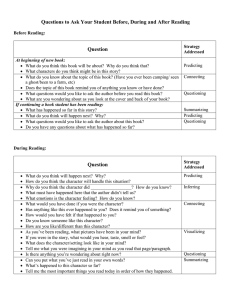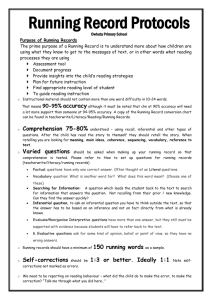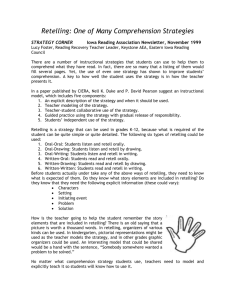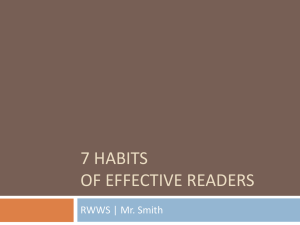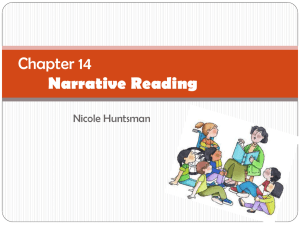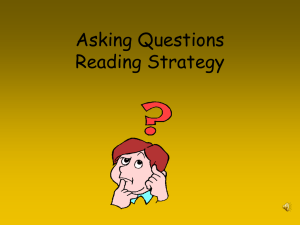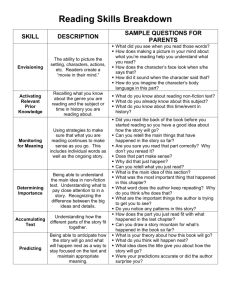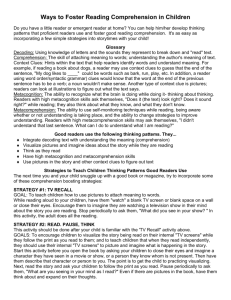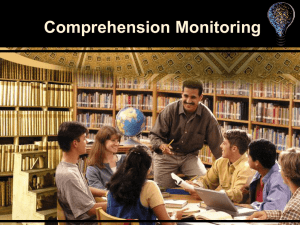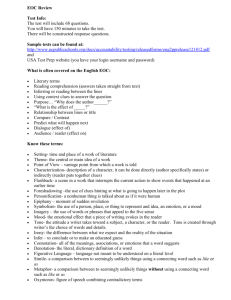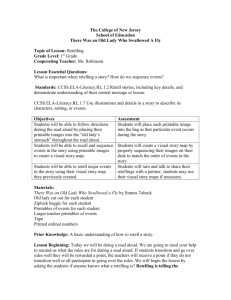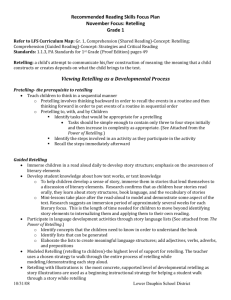Comprehension 3-5
advertisement
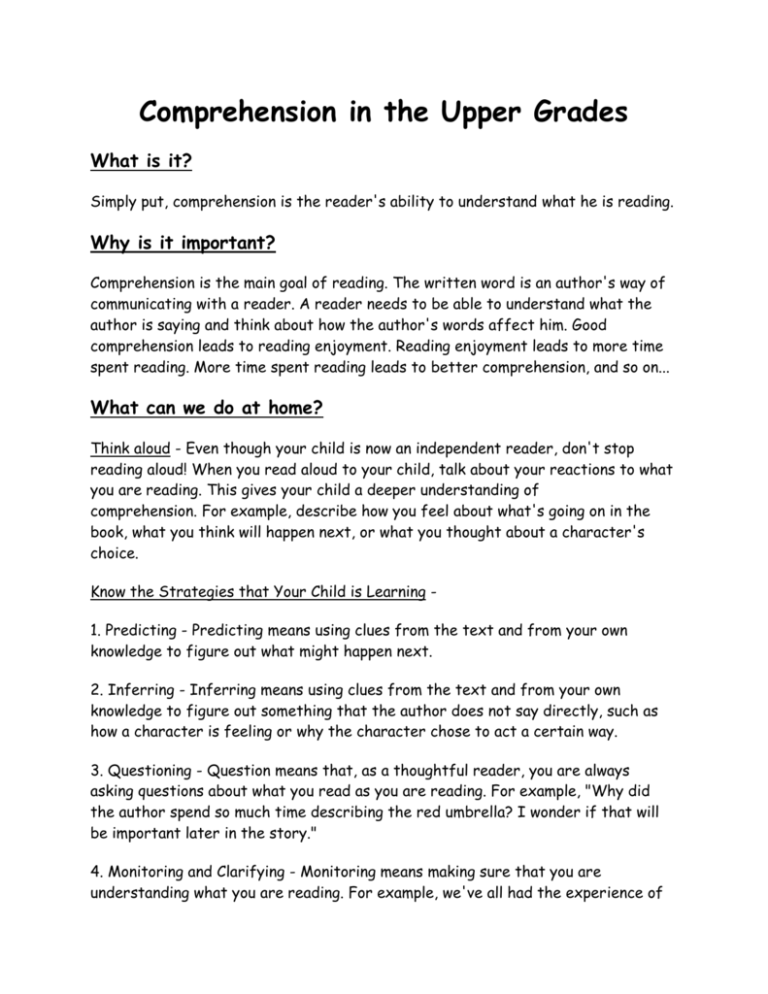
Comprehension in the Upper Grades What is it? Simply put, comprehension is the reader's ability to understand what he is reading. Why is it important? Comprehension is the main goal of reading. The written word is an author's way of communicating with a reader. A reader needs to be able to understand what the author is saying and think about how the author's words affect him. Good comprehension leads to reading enjoyment. Reading enjoyment leads to more time spent reading. More time spent reading leads to better comprehension, and so on... What can we do at home? Think aloud - Even though your child is now an independent reader, don't stop reading aloud! When you read aloud to your child, talk about your reactions to what you are reading. This gives your child a deeper understanding of comprehension. For example, describe how you feel about what's going on in the book, what you think will happen next, or what you thought about a character's choice. Know the Strategies that Your Child is Learning 1. Predicting - Predicting means using clues from the text and from your own knowledge to figure out what might happen next. 2. Inferring - Inferring means using clues from the text and from your own knowledge to figure out something that the author does not say directly, such as how a character is feeling or why the character chose to act a certain way. 3. Questioning - Question means that, as a thoughtful reader, you are always asking questions about what you read as you are reading. For example, "Why did the author spend so much time describing the red umbrella? I wonder if that will be important later in the story." 4. Monitoring and Clarifying - Monitoring means making sure that you are understanding what you are reading. For example, we've all had the experience of reading to the end of the page and not remembering what we've read. When we realize that, we are monitoring our reading. Clarifying means clearing up any misunderstanding or lack of understanding. For example, if you didn't remember what you had read, you might choose to reread that page. 5. Retelling and Summarizing - Retelling means telling what happened in your own words. With fiction, a good retell usually includes characters, setting, problem, events in order, and solution. Summarizing is like giving a very short retell. In a summary, the reader includes only the most important details. 6. Visualizing - Visualizing means imagining the text in your head, like a picture or movie in your mind. Some readers do this automatically, but others need coaching. For example, if the story is about children having a lemonade stand, you might picture the weather, how busy the street was, what type of neighborhood it is in, what the children are wearing, or how many people are gathered around. These are details that the author may not include, but they help the reader better understand the story and get that feeling of "being there." Reading fiction 1. Here are two strategies to use before beginning a fiction book. Predicting - Have your child look at the cover and the first page and make a prediction about what will happen in the story. Emphasize using clues from the story and from personal knowledge. Questioning - Encourage your child to create a couple of questions that he would like the author to answer in the book. This gives your child a purpose or a goal for reading. 2. While reading, try these strategies. Predicting - Stop at various points, particularly at the end or chapters or at very exciting points, and ask your child, "What do you think will happen next? Why?" Questioning - Encourage questioning. "Do you have new questions about what's going on in the story? What do you wonder?" Inferring - Help your child think about the character's actions, words, and feelings. "Does the author give any clues about why the character is acting certain way or how the character is feeling or why the character would say what he did? Have you ever had an experience like the character's?" Monitoring and Clarifying with a Retell/Summary - Stop every few pages or at the end of the chapter and ask your child to tell you what has happened so far in the story. If he can do this, continue on with the story. If he cannot, try rereading the section together to figure out where the misunderstanding took place. Visualizing - Every now and then, stop and ask your child to describe the picture in his mind at this part in the story. If necessary, ask questions to help your child make this picture more vivid and detailed. 3. After reading, emphasize the strategy of retelling/summarizing. You may have had your child retell pieces of the story as he read; now it's time to retell the story as a whole. PS - There's no need to work on every strategy every time. In fact, that would really interfere with the flow and enjoyment of the story. Choose one or two strategies at a time. Reading Nonfiction 1. Here are two strategies to use before beginning a nonfiction book. Predicting – Preview the cover and the table of contents. Ask your child to think about what he would like to find out by reading this book. Ask him if he thinks this book will give him the information that he is looking for. Questioning – After looking at the cover and the table of contents, ask your child what questions he would like this book to answer. This helps set a purpose for reading. 2. While reading, try these strategies. Questioning - Have your child continue asking questions as he reads and to notice when the text answers his questions. Monitoring and Clarifying - Help your child make sure he monitors his reading by stopping at the end of a section or chapter to ask, "Did I understand what I just read? If not, what can I do about it?" Retelling/Summarizing – Reinforce the idea of main idea and supporting details. Ask your child, “What was this section mostly about?” This is the main idea. Then ask, “What details tell more about the main idea?” 3. After reading, wrap up the discussion. Questioning - Ask your child, "Did the book answer your questions? What do you still want to know?" Inferring - Help your child use his background knowledge and clues from the text to figure out how the author feels about the topic and what the author's message is. For example, "I think that the author admires Wilma Rudolph's perseverance, and the author's message is to believe in yourself and never give up just like Wilma Rudolph." Retelling/Summarizing – As before, reinforce main idea and supporting details. Ask your child, “What was this book mostly about?” This is the main idea. Then ask, “What details tell me more about the main idea?” Another apprach is to ask, "What do you think the author would like you to remember after reading this book?" PS - As with fiction, focusing on one or two strategies at a time is much more effective than trying to do everything at once. BluevalleyK12.org
